Thoresby & Perlethorpe during World War 2
Above: Situated in the woods opposite Thoresby Courtyard this vehicle maintenance ramp. Built to support the weight of military vehicles stationed on the estate during the war years.
During World War 2 the Midlands became a training ground for tank crews. The MoD thought that the terrain might be suitable if it resembled that of France. (Wrong). During this time both Thoresby Hall and The Kennels were taken over by the military. However, this article is not about the military aspect of those years but rather the activities of the people of Perlethorpe and Thoresby.
The Perlethorpe and Budby War Effort:
The women of both villages organized several contributions towards the war effort. From November 1939 to February 1940 they knitted assorted garments for the Notts Services Comforts Fund. Everything from pants to blankets. Both villages also donated eggs to Mansfield hospital, whilst a waste paper salvage scheme in PerlethorpeVillage involved boys making weekly collections for a stockpile to be sold in Nottingham. Similarly a dump was established for tins and bones, waste materials helpful in the production of munitions. Mrs Dawson ran Perlethorpe Post Office at this time and she organized a successful National Savings Scheme for both villages to help fund the fight for victory, whilst other women instigated a Perlethorpe Spitfire Fund. 1941 saw a further fund raiser: Warship Week.
Perlethorpe School during the war:
During 1940 the school only closed for one week in August. This was on account of all the evacuees on the estate who naturally needed monitoring as much as educating during what must have been a stressful time. Thoresby started taking in evacuees from the South as early as June 1940. It also received evacuees from Sheffield before the end of that year. One activity the school children are known to have been involved in was the posting of tobacco to sailors via the Overseas League, for which they received postcards of thanks. Of much less fun must have been the regular practice sessions wearing gas masks for fifteen minutes at a time. In early 1941 parents received a letter advising their children be inoculated against diphtheria, but I was surprised to discover a County Survey health report from March that found the children to be sub normal regarding their nutrition levels. And this in a countryside where fresh meat and vegetables were plentiful? The school raised further donations to the war effort by Carol Singing, which was duly sent to the Chancellor of the Exchequer, resulting in a mention on BBC radio news in December 1941. The year after that their carols raised money for Red Cross Prisoners of War, whilst the girls made and sold soft toys to support the Wings for Victory fund. In January 1942 temperatures inside the school dipped below freezing, and a subsequent outbreak of mumps and whooping cough in February and May was perhaps not surprising. In the Summer of 1942 funds were raised by children collecting nettles for the medicinal properties. The following year they collected Foxgloves for the same reason. 1943 was an important year in the history of the school as it saw the start of a school canteen system, providing a hot dinner for the significant number who stayed during the lunch break.
(See more about Perlethorpe School on THIS LINK).
Was Thoresby Estate bombed during the war?
During late August 1940 Thoresby, Budby and nearby Walesby were bombed on four occasions. Light, probably speculative attacks. Air raid warden W A Mendham noted in his diary that a rabbit was killed on the 19th August in the north of Budby. But the following week the Woodyard actually caught fire from an incendiary bomb. In May 1944 a Wellington bomber from Gamston, intended to be taking part in a supply drop on France, suffered engine failure over Thoresby and collided with the tree tops. It crashed North West of the Kennels (before the junction with Netherfield Lane.) Five of the six man crew were killed.
After the War:
During the 1950s, long after the tanks had all left the Park, the children of Thoresby Estate were left with one very tangible reminder of their presence. The infamous Tank Dip! Constructed on the north of the estate, the other side of Netherfield Lane from the Hall, and slowly filled by a tap from Piper Well underground reservoir, this stagnant installation which had once tested the waterproofing on the tanks became the school swimming pool. I remember hanging on to a pole the width of the pool, together with the rest of the class, and being dragged down its length. I'm unsure whether we were meant to be learning to swim or simply dredging the green scum from the surface. (Note: Contrary to some opinions, the Tank Dip is now filled in and planted over.)
Credit where it's due: The years described in the above post are before my time on the estate. My research comes from several lectures, conversations and sources. But the "Thoresby Park" research notes compiled by C. A. Bollans, especially where they relate to Perlethorpe School, were of particular and valid help and I credit them as such.
Labels: Manvers, Perlethorpe Village, Pierrepont, the Dukeries, Thoresby at War, Thoresby Estate, Thoresby Hall, Thoresby Park, World War 2




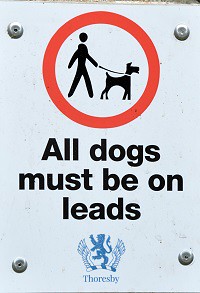 Thoresby Hall Hotel, Sherwood Forest and Clumber Park are recommended attractions for a day trip or short vacation. The
Dukeries area is of keen historic interest. NOTE: Apart from public domain postcards and brochures ALL photographs herein are copyright Ian Gordon Craig, exclusive permission granted to Thoresby Estate for their use elsewhere.
Thoresby Hall Hotel, Sherwood Forest and Clumber Park are recommended attractions for a day trip or short vacation. The
Dukeries area is of keen historic interest. NOTE: Apart from public domain postcards and brochures ALL photographs herein are copyright Ian Gordon Craig, exclusive permission granted to Thoresby Estate for their use elsewhere.
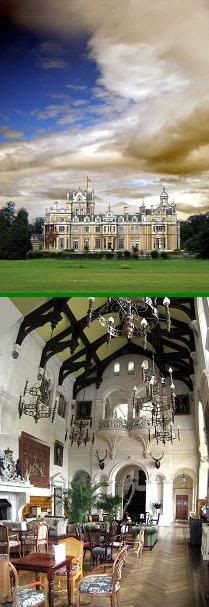 Thoresby Hall as photographed Summer 2009, now a successful Warners Hotel.
Thoresby Hall as photographed Summer 2009, now a successful Warners Hotel.
 Robert Pierrepont (1584 - 1643), 1st Earl of Kingston upon Hull, bought Thoresby for his second son William.
Robert Pierrepont (1584 - 1643), 1st Earl of Kingston upon Hull, bought Thoresby for his second son William.
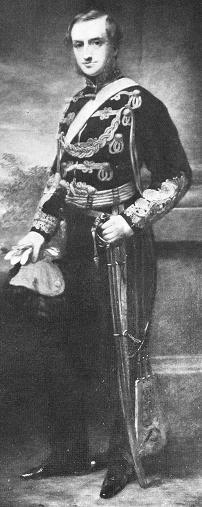 Sydney William Herbert Pierrepont (1825 - 1900), 3rd Earl Manvers, built the present Thoresby Hall, St John's Church,
Perlethorpe School, and generally shaped Thoresby Estate as it looks today.
Sydney William Herbert Pierrepont (1825 - 1900), 3rd Earl Manvers, built the present Thoresby Hall, St John's Church,
Perlethorpe School, and generally shaped Thoresby Estate as it looks today.
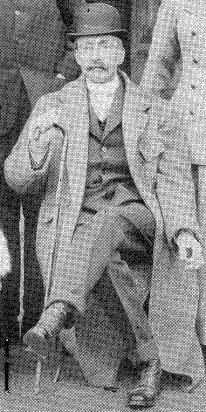 The 4th Earl Manvers (Died 1926).
The 4th Earl Manvers (Died 1926).
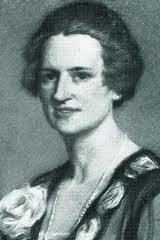 Countess Manvers (d.1984). Examples of her paintings are always on show at Thoresby Gallery.
Countess Manvers (d.1984). Examples of her paintings are always on show at Thoresby Gallery.
 ABOVE: The statue of Robin Hood in the courtyard at Thoresby Hall, by Tussaud - Birt, is showing its age, but remains one of
my favourites. The Art Gallery, crafts shops, and restaurant within that courtyard are recommended.
ABOVE: The statue of Robin Hood in the courtyard at Thoresby Hall, by Tussaud - Birt, is showing its age, but remains one of
my favourites. The Art Gallery, crafts shops, and restaurant within that courtyard are recommended.

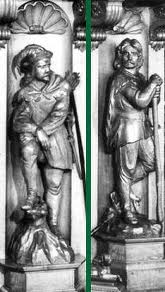
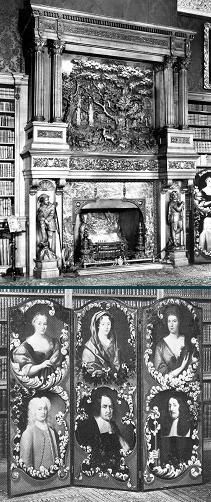 Carved oak fireplace in the Thoresby Hall library with its depiction of the Major Oak (Robin Hood's Tree), and the screen
featuring the Cromwell family. Oliver Cromwell is known to have stayed in Thoresby Hall before the English Civil War.
Carved oak fireplace in the Thoresby Hall library with its depiction of the Major Oak (Robin Hood's Tree), and the screen
featuring the Cromwell family. Oliver Cromwell is known to have stayed in Thoresby Hall before the English Civil War.
 The Green Bridge sited near the edge of the cricket pavilion in front of Thoresby Hall across which the Duke's carriage would take him to Perlethorpe Village.
The Green Bridge sited near the edge of the cricket pavilion in front of Thoresby Hall across which the Duke's carriage would take him to Perlethorpe Village.
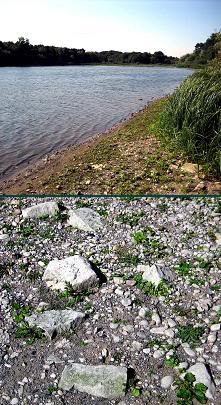 The view along Thoresby Lake towards Budby. Are these bricks at the water's edge remnants from the original Thoresby
Hall?
The view along Thoresby Lake towards Budby. Are these bricks at the water's edge remnants from the original Thoresby
Hall?
 The River Meden winds its way from 7 Ton Bridge near Thoresby Hall towards Perlethorpe Village.
The River Meden winds its way from 7 Ton Bridge near Thoresby Hall towards Perlethorpe Village.
 Budby Castle, once known as William Castle, and the River Meden winding towards Thoresby Lake under the remains of
Pierrepont Bridge, once described as classical and elegant.
Budby Castle, once known as William Castle, and the River Meden winding towards Thoresby Lake under the remains of
Pierrepont Bridge, once described as classical and elegant.
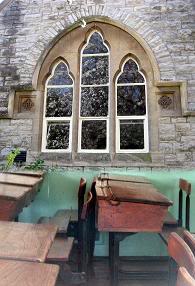
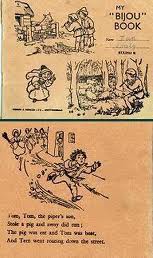 Children's exercise book from the school, 1958.
Children's exercise book from the school, 1958.
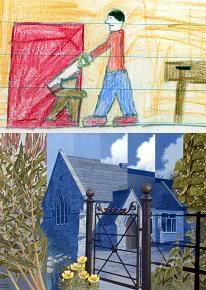
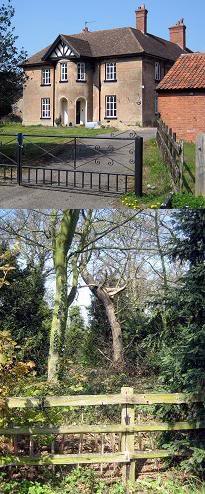



 Perlethorpe Church graveyard, where the original chapel once stood. The covered gate was a later addition in memorium to
the men of Budby and Thoresby who fell in World War 1.
Perlethorpe Church graveyard, where the original chapel once stood. The covered gate was a later addition in memorium to
the men of Budby and Thoresby who fell in World War 1.
 Robin Hood's Tree, the Major Oak, was once under the care and supervision of Thoresby Estate. Responsibility for its
upkeep changed to Nottingham City Council c.1969. Here it is pictured in in Spring, Autumn, and Winter.
Robin Hood's Tree, the Major Oak, was once under the care and supervision of Thoresby Estate. Responsibility for its
upkeep changed to Nottingham City Council c.1969. Here it is pictured in in Spring, Autumn, and Winter.
